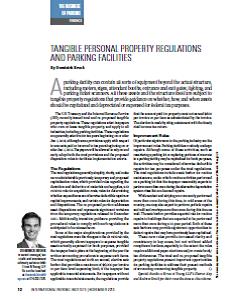A parking facility can contain all sorts of equipment beyond the actual structure, including meters, signs, attendant booths, entrance and exit gates, lighting, and parking ticket scanners. All these assets and the structure itself are subject to tangible property regulations that provide guidance on whether, how, and when assets should be capitalized and depreciated or expensed for federal tax purposes.
The U.S. Treasury and the Internal Revenue Service (IRS) recently issued final and re-proposed tangible property regulations. These regulations affect taxpayers who own or lease tangible property, and apply to all industries, including parking facilities. These regulations are generally effective for tax years beginning on or after Jan. 1, 2014, although some provisions apply with respect to amounts paid or incurred in tax years beginning on or after Jan. 1, 2013. Taxpayers will be allowed to rely on and early-adopt both the final provisions and the proposed disposition rules to facilitate implementation efforts.
The Regulations
The final regulations generally simplify, clarify, and make more administrable previously temporary and proposed capitalization rules, which provided rules regarding the definition and deduction of materials and supplies, a de minimis rule for acquisition costs, rules for determining whether expenditures are otherwise deductible repairs or capital improvements, and certain rules for depreciation and dispositions. The re-proposed portion addresses asset dispositions and represents significant revisions from the temporary regulations released in December 2011. Additionally, transition guidance providing the procedural rules to comply with such regulations is anticipated to be released soon.
Some of the major simplifications provided by the final regulations were the changes to the de minimis rule, which generally allows taxpayers to expense tangible assets actually expensed for book purposes, provided the taxpayer has in place at the beginning of the year the written accounting procedures to expense such items. The final regulations set forth an annual, elective safe harbor that provides a maximum of $5,000 per invoice or per item level expensing limit, if the taxpayer has applicable financial statements. For taxpayers without applicable financial statements, the regulations provide that the amount paid for property must not exceed $500 per invoice or per item as substantiated by the invoice. The election is made by filing a statement with the timely filed income tax return.
Improvement Rules
Of particular significance to the parking industry are the improvement rules. Parking facilities routinely undergo repairs. Although some of these activities, such as resurfacing a parking lot or replacing portions of concrete in a parking facility, may be capitalized for book purposes, the activities may be considered otherwise deductible repairs for tax purposes under the final regulations. The final regulations include a safe harbor for routine maintenance, under which routine activities performed on a parking lot that the taxpayer reasonably expects to perform more than once during the alternative depreciation system class life are deemed repairs.
While sealant and striping are commonly performed more than once during this time, in cold areas of the country, one may also expect to perform pothole repairs and mill and overlays more than once during this time as well. The safe harbor provides a special rule for routine repairs to buildings that are expected to be performed more than once during a 10-year period. Both of these safe harbors may provide significant opportunities to deduct repairs that may have previously been capitalized.
These new rules provide increased clarity and consistency in key areas, but not without added compliance burdens, especially to the extent the rules require additional paper elections and/or create book/tax differences. The final and re-proposed tangible property regulations present important opportunities for parking facilities to address their present methods of accounting concerning tangible property.
Special thanks to Ernst & Young LLP’s Sharon Kay and Andrew Smith for their contributions to this column.
Dominick Brook is senior manager, tax credit and investment advisory services with Ernst & Young LLP. He can be reached at dominick.brook@ey.com or 614.232.7376.
TPP-2013-11-Tangible Personal Property Regulations and Parking Facilities

